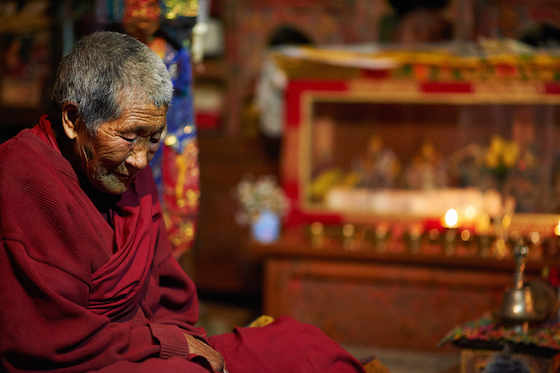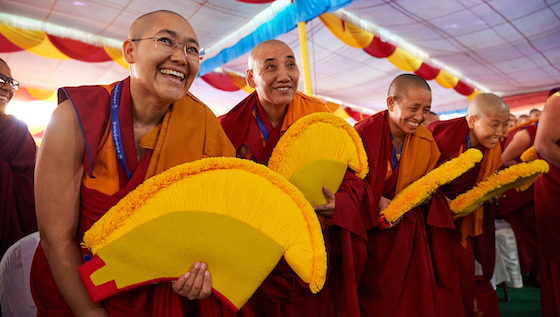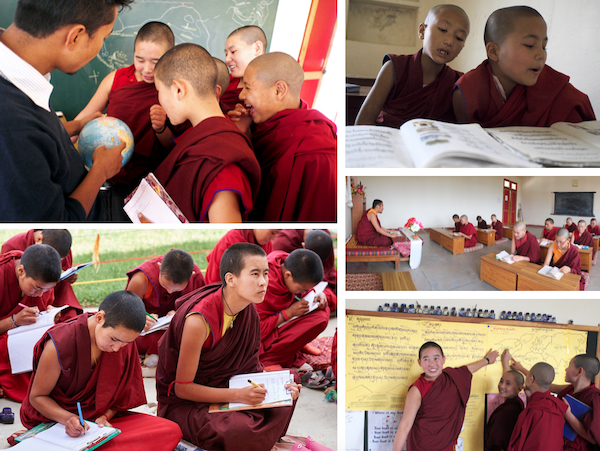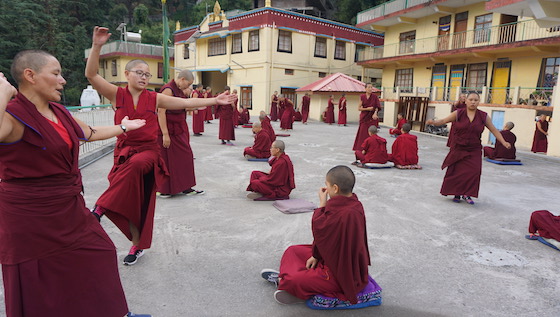The following Q&A about the education of Tibetan Buddhist nuns is a special interview with Elizabeth Napper, PhD. Dr. Napper is the US Founder and Board Chair of the Tibetan Nuns Project and is a scholar of Tibet and Tibetan Buddhism. She is the author of Dependent-Arising and Emptiness, translator and editor of Mind in Tibetan Buddhism, and co-editor of Kindness, Clarity and Insight by His Holiness the Dalai Lama.
Q: What was education like in Tibet before 1959?
A: Traditionally, Tibet pre-1959 was a pre-industrial age feudal society for the most part. There was no general education and, in pre-1959 Tibet, that was true of the lay people as well. Education was a specialized skill for people who needed it. The children of traders would get an education because they were carrying out a business and the people who were going to be government functionaries, who worked in the government, were well educated. But ordinary people were not literate. So that was the starting point.

An elderly Tibetan Buddhist nun meditating in Zanskar, northern India. Historically, nuns had little access to education but spent their time in prayer and meditation. Photo courtesy of Olivier Adam
Q: In Tibet, how did the lives of monks and nuns differ?
A: In Tibet, a large part of the population, both men and women, chose the monastic lifestyle, but that meant very different things. In some ways, the majority of monasteries and nunneries were not all that different. The bulk of them were relatively small institutions in villages and local communities, and the major function of monks and nuns was to do prayers on behalf of the lay people. Lay people made offerings to monks and nuns who then performed prayers on their behalf. That was the back and forth between these two groups of people.
However, the monasteries had a very rich and active intellectual tradition going back to the 11th century when Buddhism was revived in Tibet. Monks had the opportunity go to larger institutions and engage in the study of the philosophical tradition of Buddhism. By contrast, nuns who were motivated to do more would go into retreat and spend long periods of time in solitary meditation, often showing profound results of that meditation and revered for their internalized level of realization.
However, neither of monks nor nuns were literate much beyond the ability to read and recite the prayers.
After 1959, when many Tibetans fled Tibet, the large monastic institutions were re-established in exile. Far fewer nuns came out. Slowly institutions were established for the nuns, but just as the nuns in Tibet didn’t have education, neither did the new nunneries in India. That was the situation when the Tibetan Nuns Project started out.

A Tibetan Buddhist nun in exile practices calligraphy. Educating the nuns is the core of our work. In the 1980s and 1990s, when hundreds of nuns were escaping from Tibet, the overwhelming majority of the nuns were totally illiterate. Most of the newly arrived nuns had had no education in their own language. Photo courtesy of Tenzin Sangmo
Q: Why is it important that nuns have equal access to education and the same opportunities as monks?
A: The goal of the Tibetan Nuns Project has always been to give the nuns access to education. It is a given, that in a modern world, you need education and a basic understanding to function well in modern society. In addition, it is limiting to push nuns towards the meditative retreat side of things. It is important to give nuns the same access that monks have to the philosophical, the conceptual understanding of their tradition. This means not just studying abstract philosophy; it is understanding the nature of reality so that you can apply that in your meditation to attain levels of realization. Our primary motivation was to open up to the nuns those levels for spiritual progress. But, additionally, they needed education simply to be able to manage their monastic institutions themselves, rather than relying always on male direction.

In 2016, twenty nuns made history when they were awarded the Geshema degree. This degree is equivalent to a PhD in Tibetan Buddhist philosophy and was only formally opened up to women in 2012. Detail of photo by Olivier Adam.
Q: What were some of the obstacles to setting up an education program for the nuns?
A: It was tricky because it wasn’t easy to find teachers. Also, the nunneries were dependent upon the financial support they got from the lay community coming for prayers, and those prayers took up the better part of the nuns’ days. They were concerned that if they set up a study program and nuns weren’t doing prayers all day, the nunneries wouldn’t get in enough funding to support them. So that was a big part of the sponsorship program that we started – to provide alternative support so that everyone wouldn’t have to spend all day doing prayers on behalf of the lay community – not that they weren’t willing to do those prayers, but we needed to find a way to make it not be the only thing for them to do. That was the starting point.
Q: What are some of the major accomplishments in education for the nuns so far?
A: The result of educating nuns is that we now have nuns who have been trained up to the point of the highest degree of their tradition, the Geshe degree (Geshema degree for the nuns).
Some of the major educational accomplishments are:
- The creation of groundbreaking education program for nuns
- Providing debate training for nuns for the first time in the history of Tibet
- Supporting the annual Jang Gonchoe inter-nunnery debate event, which provides one month of intensive training in debate
- Enabling nuns to take the Geshema exams and pursue other higher degrees
- Creating a Tantric Studies program for Geshemas to empower them to become teachers and leaders

A collage of photos of education of Tibetan Buddhist nuns. Bottom left photo courtesy of Olivier Adam; other photos courtesy of Brian Harris.
Q: Why is training in debate so important?
A: The system of education teaches rational, logical thought. The nuns (and monks) use a formalized style of debate in which you set out a premise and debate it. In Tibetan Buddhist debate, you have to prove two things about what you’re saying: (1) that whatever it is you’re trying to prove is true, that your reasoning is correct and (2) that the reason applies to what you’re trying to prove.
This is the opposite to advertising. For example, the advertising of beauty products says, “If you use this product, your life will be good.” This is false pervasion. Also, it can say things that are just not true. Conversely, debate teaches you to avoid that kind of illogical thinking.
Q: What can the world learn from the way the nuns debate?
A: Illogical thinking is what a lot of political discourse that we are hearing is based on. Things that are absolutely not true are being said. In addition, things are being said that may be true but don’t at all imply what is being drawn out of them. That is the real world that we live in.
The ability to see clearly and logically is the training that the nuns are doing. This helps them to not just accept things that aren’t true being presented as if they were. You can see through falsities and also see false pervasions such as “If you use this product, if you believe in this person, your life will be good.” That it is not necessarily going to happen. That is the real-world application. We gain by having a population who are educated in that way and have a clear understanding of what they are doing in the world.
It is also very important to the Buddhist philosophical tradition, which is not based on faith alone, but is based on developing a penetrating understanding of the nature of reality. This is the final purpose of the studies they have undertaken, and the years of study and debate are directed towards that.
Along the way, of course, this is a religious tradition, and in the Tibetan tradition, there is a great emphasis of developing universal love and compassion, of wishing the best for each and every living being. All those things are important components of the education that the nuns are receiving.

Tibetan Buddhist nuns practice debate at Geden Choeling Nunnery in Dharamsala. Tibetan Buddhist debate teaches many skills including critical thinking, logic, attentional focus, memory, and confidence in one’s reasoning skills. Until the 1990s, Tibetan nuns were not taught how to debate.
Q: How has educating the nuns created leaders, teachers, and role models?
A: We put in place these programs to open those kinds of studies up for nuns. Now, 30 years later, those groups of nuns have been able to pass through this entire course of study that have been followed by the monks for centuries. The nuns are starting to go out and take on roles of leadership in the community – they are teaching in the nunneries, some of them are teaching in the Tibetan schools, and one nun has been added to the election commission of the exile government based in Dharmsala. This is the impact, not just of their philosophical knowledge, but of their training and clear thought motivated by a compassionate wish to help.
Q: Do you see growing confidence in the nuns?
A: The nuns have growing confidence to take on leadership roles. Before, when the nuns didn’t know anything, when they hadn’t studied and they could barely read or write, they had no confidence. There was no way they could serve in these roles or as role models in their community. That has now changed. People see these nuns who are able to debate as well as the monks, who can hold their own in those kinds of contests, who exude this body language of confidence, who are also prepared to take on leadership roles. This has broadened the base out of potential leaders in the community from only one gender to both genders.

I am interested in becoming a buddhist monk my name is haven dearing and I am 21 where do I apply for this or begin
Dear Haven, we only work with Tibetan nuns (females) not monks. We suggest that you search out a Tibetan Buddhist center nearest to you and talk to the teacher or lama there.